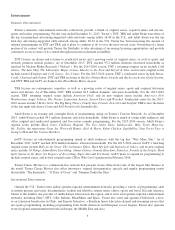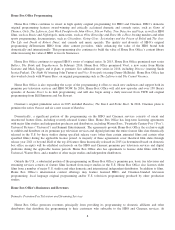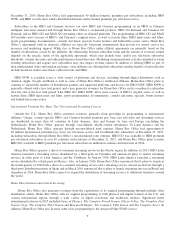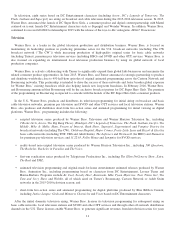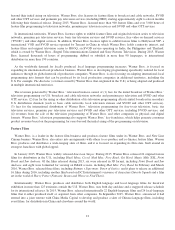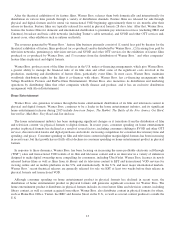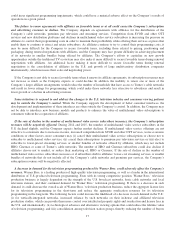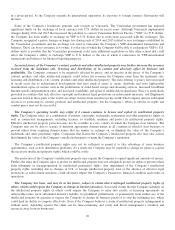Time Magazine 2015 Annual Report Download - page 27
Download and view the complete annual report
Please find page 27 of the 2015 Time Magazine annual report below. You can navigate through the pages in the report by either clicking on the pages listed below, or by using the keyword search tool below to find specific information within the annual report.After the theatrical exhibition of its feature films, Warner Bros. releases them both domestically and internationally for
distribution in various time periods through a variety of distribution channels. Feature films are released for sale through
physical and digital formats and for rental via transactional VOD beginning approximately three to six months after their
release in theaters. Feature films are typically released for rental in physical formats 28 days later. After that, Warner Bros.
licenses the feature films for domestic and international distribution to premium pay television services (including HBO and
Cinemax), broadcast and basic cable networks (including Turner’s cable networks), and SVOD and other OTT services and,
in most cases, other exhibitors such as airlines and hotels.
The revenues generated by Warner Bros.’ feature film business primarily consist of (1) rental fees paid by theaters for the
theatrical exhibition of feature films produced (or co-produced) and/or distributed by Warner Bros., (2) licensing fees paid by
television networks, premium pay television services and SVOD and other OTT services for the exhibition of feature films
produced or co-produced by Warner Bros. and (3) revenues from the distribution of Warner Bros.’ and other companies’
feature films in physical and digital formats.
Warner Bros. produces most of the films it releases in the U.S. under co-financing arrangements, which give Warner Bros.
a greater ability to manage the financial risks of its film slate and offset some of the significant costs involved in the
production, marketing and distribution of feature films, particularly event films. In most cases, Warner Bros. maintains
worldwide distribution rights for the films it co-finances with others. Warner Bros. has co-financing arrangements with
Village Roadshow Pictures and RatPac-Dune Entertainment. Warner Bros. also monetizes its distribution and marketing
operations by distributing films that other companies wholly finance and produce, and it has an exclusive distribution
arrangement with Alcon Entertainment.
Home Entertainment
Warner Bros. also generates revenues through the home entertainment distribution of its film and television content in
physical and digital formats. Warner Bros. continues to be a leader in the home entertainment industry, and its significant
home entertainment releases during 2015 include American Sniper,The Hobbit: The Battle of the Five Armies,Get Hard,
Interstellar,Mad Max: Fury Road and San Andreas.
The home entertainment industry has been undergoing significant changes as it transitions from the distribution of film
and television content via physical formats to digital formats. In recent years, consumer spending on home entertainment
product in physical formats has declined as a result of several factors, including consumers shifting to SVOD and other OTT
services, discount rental kiosks and digital purchases and rentals; increasing competition for consumer discretionary time and
spending; and piracy. Consumer spending on film and television content in higher margin digital formats has been increasing
in recent years, but that growth has not fully offset declines in consumer spending on home entertainment product in physical
formats.
In response to these dynamics, Warner Bros. has been focusing on increasing the more profitable electronic sell-through
(“EST”) sales and transactional VOD rentals of its film and television content and is an innovator in a variety of initiatives
designed to make digital ownership more compelling for consumers, including UltraViolet. Warner Bros. licenses its newly
released feature films as well as films from its library and its television content to EST and transactional VOD services for
viewing online and on mobile platforms in the U.S. and internationally. In the U.S. and most major international markets,
Warner Bros.’ recent theatrical releases are generally released for sale via EST at least two weeks before their release in
physical formats and transactional VOD.
Although consumer spending on home entertainment product in physical formats has declined in recent years, the
distribution of home entertainment product in physical formats still generates significant revenues for Warner Bros. The
home entertainment product it distributes in physical formats includes its own feature films and television content, including
library content, as well as content acquired from others. Warner Bros. also distributes content in physical formats for others,
such as Home Box Office, Turner, the BBC and Sesame Street in the U.S., as well as several content producers outside the
U.S.
13




